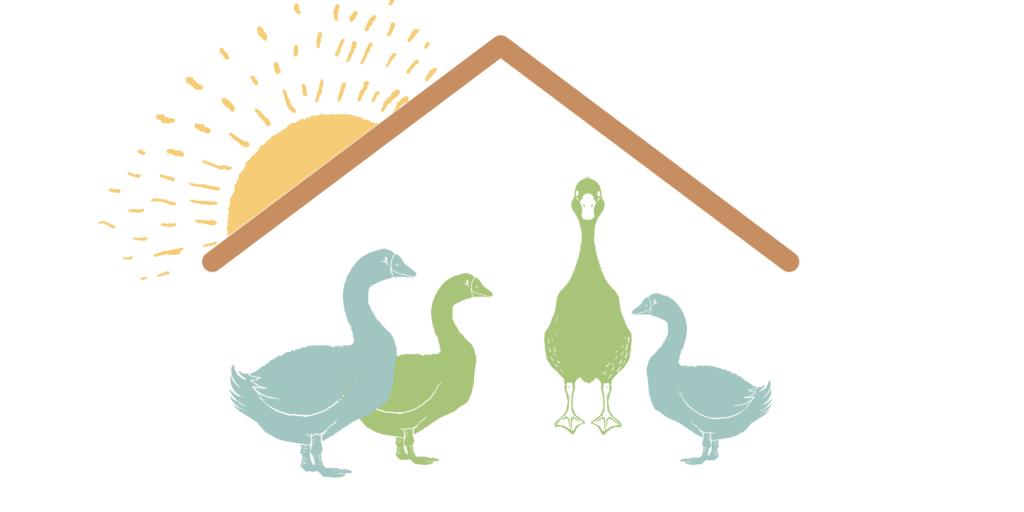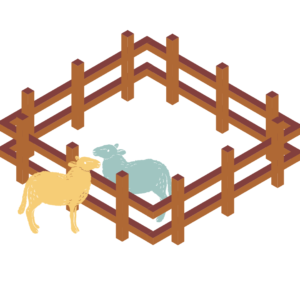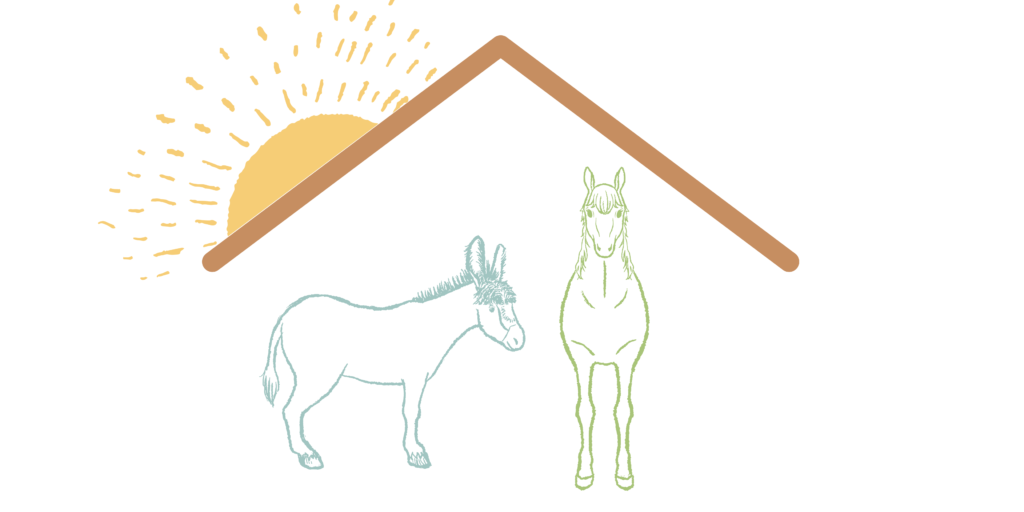
Providing social spaces can be a great way to provide enriching experiences for residents. Previously, we’ve discussed social and other enrichment types in our Time To Thrive series and within enrichment resources for particular resident species. In this resource, we will look at different ways you can provide opportunities for social enrichment for residents at your sanctuary. For many residents, social spaces are vital to their well-being. So what do you do when residents are temporarily separated, haven’t been socialized, or have lost someone close to them? What are some enrichment strategies that involve social spaces? Let’s take a look!
Social Enrichment
Many, if not all, farmed animal sanctuaryAn animal sanctuary that primarily cares for rescued animals that were farmed by humans. residents are likely to be social species. Whenever possible, residents should be able to engage in natural social structures. Unfortunately, this isn’t always possible due to space, the number of residents, personalities, health status, or the necessary imposed limitations surrounding reproductive behavior. However, all steps should be taken to ensure social residents meet their social needs, generally by sharing appropriate living spaces with other residents of the same species. However, it is important to consider the individuals and not necessarily just lump every resident of the same species in with one another. (Read more about planned living arrangements here.)
Enrichment Strategies Overlap!
As we cover each area of social enrichment, you will notice that some social enrichment overlaps with different enrichment categories, such as sensory enrichment. For example, you might provide slightly soiled bedding to an individual who is temporarily isolated from their companions. This could be considered a form of social and sensory enrichment, stimulating the senses and providing a social connection for the individual.
Social Enrichment With Others In their Species

This one may be the most obvious. Social species should ideally have opportunities to live among and develop natural social relationships with others of their species. You might think, “Well, this sounds like a need, not a form of enrichment.” And we agree that this really is a need that should be met. However, we also want to reinforce the idea of enrichment as an important aspect of general care for residents, a shift of mindset from “survive” to “thrive”!
There are two approaches to providing social opportunities for residents with others of their own species. One way is to provide social experiences through co-living (sharing a living spaceThe indoor or outdoor area where an animal resident lives, eats, and rests.). But remember, something is only enriching if the individual finds it so! If social relationships are abnormally contentious or individuals have predominantly negative experiences in their social spaces, this isn’t particularly enriching for them. In those cases, you may have to consider restructuring the group to help ensure enriching relationships. Other ways to meet immediate social needs might include taking along a beloved companion when a resident has to go to the vet or needs to be separated from more rambunctious group members while they heal from an injury. Even sharing a fenceline and being able to graze next to one another can provide the necessary social enrichment for an individual while healing. But what about beyond that?
Aside from sharing living spaces, another way of providing social enrichment between members of the same species focuses on the senses. Providing visual, auditory, olfactory, and tactile forms of social enrichment can provide enriching spaces when sharing a living space isn’t possible. This may be due to temporary situations like quarantine, isolationIn medical and health-related circumstances, isolation represents the act or policy of separating an individual with a contagious health condition from other residents in order to prevent the spread of disease. In non-medical circumstances, isolation represents the act of preventing an individual from being near their companions due to forced separation. Forcibly isolating an individual to live alone and apart from their companions can result in boredom, loneliness, anxiety, and distress., vet trips, or loss of companion/parent. Here are some examples:
- Provide slightly soiled bedding from the living space of others of their species when they are separated.

- Provide visual or physical contact so even if co-living isn’t possible, they can at least see each other and ascertain where they are and that they are okay.

- Provide sounds of calm, happy individuals of their species. Several studies in different species show the capacity for emotional contagion. This means that individuals may take their cue from others in their social circle, and if others are calm and content, they are more likely to be as well.

- Provide a stuffed animal for young individuals that are without access to a parent figure who cares/cared for them. There are even stuffed animals that hold microwaveable heat discs that simulate body heat.

- Provide a resident-safe mirror so they can see themselves, providing a visual of their species and possibly providing comfort. Be careful to observe to ensure it does not have the opposite effect, causing a resident to feel uncomfortable, challenged, or threatened.

- Provide enlarged pictures of their companions. (Some species can recognize pictures of their friends!)

For example, consider Louie, the new little spotted calf resident. Louie had surgery on his front leg, and as a result, he needs to be isolated, and his movements must be limited- especially playing- for the next week or two. This means his best buddy, Frederick, can’t be in the same living space, as they can get a little rambunctious when together. Of course, this separation can have a desultory effect on Louie’s well-being. In this case, developing an enrichment plan should consider Louie’s species-specific needs (social bonds) and his individual needs (specifically his bond with Frederick). Setting Louie up in a smaller living space and providing enrichment as a means of mental stimulation can assist in his healing. Examples of possible social enrichment strategies for Louie include providing visual access to Frederick, placing a big picture of Frederick (with his face looking forward) in Louie’s temporary living space, or adding a mirror. That’s right! Studies have shown that heart rates and movements drop in isolated cowsWhile "cows" can be defined to refer exclusively to female cattle, at The Open Sanctuary Project we refer to domesticated cattle of all ages and sexes as "cows." when they are provided with a mirror, and cows can recognize pictures of their friends easily!
Now that we looked at ways caregivers can provide opportunities for social enrichment between residents of the same species, let’s look at other options:
Social Enrichment With Other Non-Human Animal Species

While we have already covered that social species generally do best when provided opportunities to co-live with other members of their species, there are other ways to offer social enrichment, whether in addition to co-living with their own species or due to circumstances that have prevented this. Luckily, for some residents, spending time with species outside of their own can also be an enriching experience. In some cases, a resident may have been raised with or spent much of their time with an animal of a different species, and now they are more comfortable spending time with them than with individuals of their own species.
When this is the case, you must carefully consider how to provide a safe space for cohousing these individuals as some foods that are necessary for one individual may be toxic for another. Additionally, different species have different ways of communicating with each other. This can cause potentially uncomfortable and even dangerous situations for residents, especially if one is smaller or older or has limited mobility.
Social Enrichment With Humans

And, of course, many residents can also find interactions with humans enriching! This could look like simply hanging out with them in their living space or grooming them, talking to them, reading them books, playing an instrument for them, or having positive reinforcement learning sessions with them. Sometimes a resident may simply enjoy being near you!
The Rule Of Enrichment!
You’ll hear us say it many times, but with social enrichment strategies, and all other forms of enrichment, it’s only enriching if a resident finds it enriching! A resident who is bored, fearful, or upset at proffered enrichment is not having an enriching experience!
We hope this resource has inspired you to add social enrichment into the lives of your sanctuary residents. The benefits of enrichment are many. You can utilize social and other forms of enrichment to help ensure your residents live their best lives possible. For more general information about the different types of enrichment, check out this resource! To learn more about species-specific enrichment, click on the species you are interested in below:
SOURCES:
Five Enrichment Categories | The Shape Of Enrichment
Cattle | Animal Behavior (Non-Compassionate Source)
The Stimulating Science Of Animal Enrichment | Untamed Science (Non-Compassionate Source)
How Does Social Enrichment Produce Health Benefits? | eLife (Non-Compassionate Source)
Non-Compassionate Source?
If a source includes the (Non-Compassionate Source) tag, it means that we do not endorse that particular source’s views about animals, even if some of their insights are valuable from a care perspective. See a more detailed explanation here.








